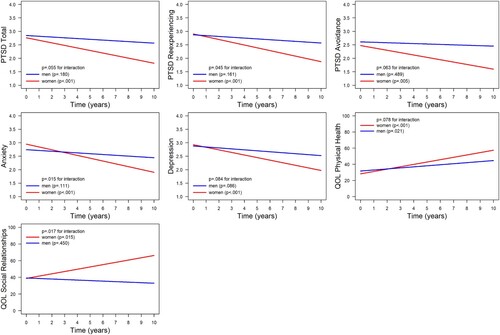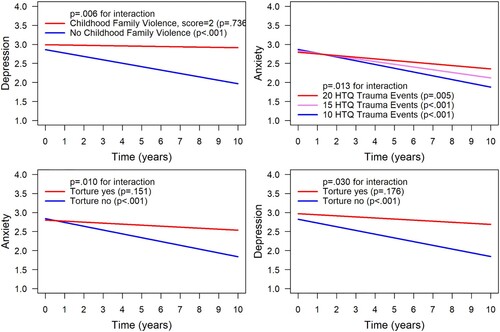Figures & data
Table 1. Literature findings regarding pretreatment demographics and trauma load as predictors of treatment outcome in clinical groups of adult refugees.
Table 2. Demographics, traumatic experiences, mental health, and quality of life at T1.
Figure 1. Prediction of the long-term course of mental health symptoms and quality of life (QoL) by gender. Mixed effects modelling of the trajectories of mental health symptoms and QoL based on the interaction between gender and time. Symptoms of post-traumatic stress disorder (PTSD) were measured by the Harvard Trauma Questionnaire (Mollica et al., Citation2004); anxiety and depression were measured by the Hopkins Symptom Checklist-25 (Mollica et al., Citation2004); QoL was measured by the World Health Organization Quality of Life BREF questionnaire (WHOQOL-BREF) (WHOQOL Group, Citation1998). The plot illustrates the trajectories over the 10 years of follow-up.

Figure 2. Prediction of the long-term course of anxiety and depression by trauma experiences. Mixed effects modelling of the trajectories of mental health symptoms and quality of life (QoL) based on the interaction between trauma variables and time. HTQ Trauma Events and symptoms of post-traumatic stress disorder (PTSD) were measured by the Harvard Trauma Questionnaire (Mollica et al., Citation2004); anxiety and depression were measured by the Hopkins Symptom Checklist-25 (Mollica et al., Citation2004); childhood family violence was assessed for this sample by Opaas & Varvin (Citation2015). The plot illustrates the trajectories over the 10 years of follow-up.

Data availability statement
The data that support the findings of this study are available on reasonable request from the corresponding author, Marianne Opaas. The data are not publicly available owing to ethical concerns, i.e. information on open data sharing was not given to participants at inclusion in the study in 2006–2009 and ethical clearance has not been given for such sharing.
